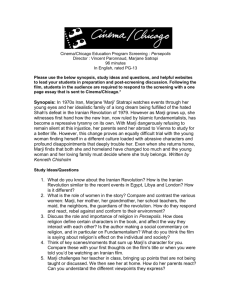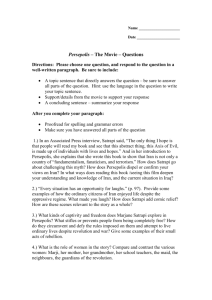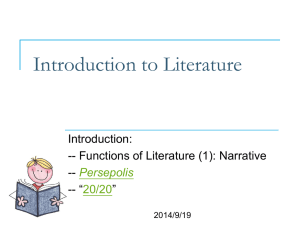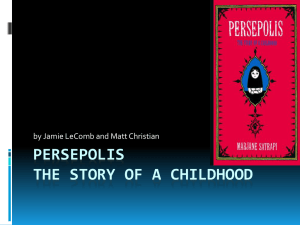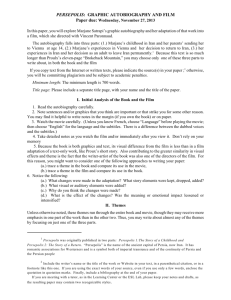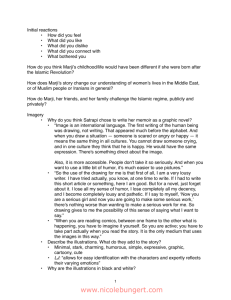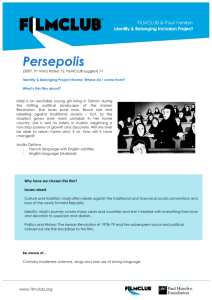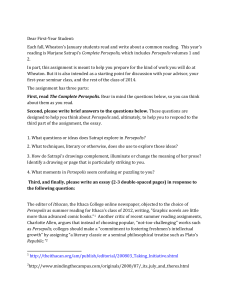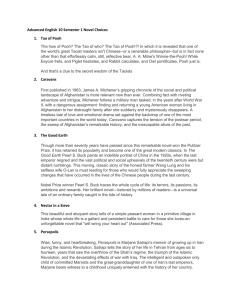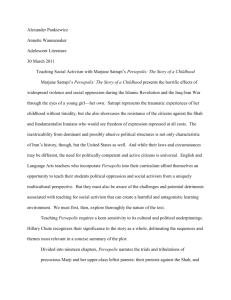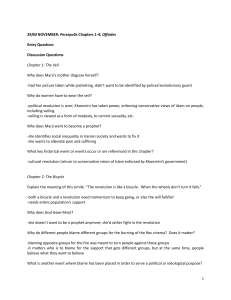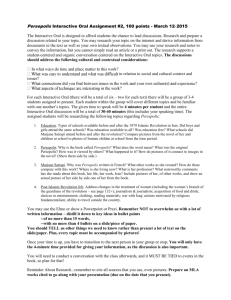Compiled Notes on Persepolis
advertisement
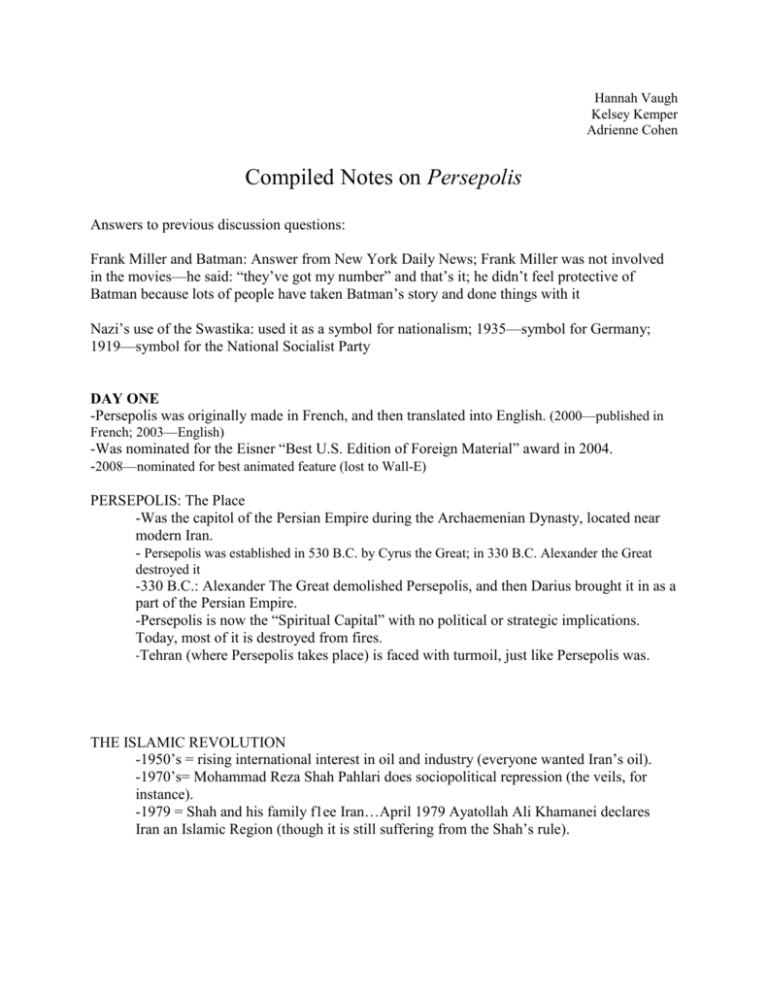
Hannah Vaugh Kelsey Kemper Adrienne Cohen Compiled Notes on Persepolis Answers to previous discussion questions: Frank Miller and Batman: Answer from New York Daily News; Frank Miller was not involved in the movies—he said: “they’ve got my number” and that’s it; he didn’t feel protective of Batman because lots of people have taken Batman’s story and done things with it Nazi’s use of the Swastika: used it as a symbol for nationalism; 1935—symbol for Germany; 1919—symbol for the National Socialist Party DAY ONE -Persepolis was originally made in French, and then translated into English. (2000—published in French; 2003—English) -Was nominated for the Eisner “Best U.S. Edition of Foreign Material” award in 2004. -2008—nominated for best animated feature (lost to Wall-E) PERSEPOLIS: The Place -Was the capitol of the Persian Empire during the Archaemenian Dynasty, located near modern Iran. - Persepolis was established in 530 B.C. by Cyrus the Great; in 330 B.C. Alexander the Great destroyed it -330 B.C.: Alexander The Great demolished Persepolis, and then Darius brought it in as a part of the Persian Empire. -Persepolis is now the “Spiritual Capital” with no political or strategic implications. Today, most of it is destroyed from fires. -Tehran (where Persepolis takes place) is faced with turmoil, just like Persepolis was. THE ISLAMIC REVOLUTION -1950’s = rising international interest in oil and industry (everyone wanted Iran’s oil). -1970’s= Mohammad Reza Shah Pahlari does sociopolitical repression (the veils, for instance). -1979 = Shah and his family f1ee Iran…April 1979 Ayatollah Ali Khamanei declares Iran an Islamic Region (though it is still suffering from the Shah’s rule). HISTORY -“Everything in Persepolis actually happened; it’s an autobiography.” -The novel is biased because she was a child, and she was raised to be of the revolution. -Surprising elements of depression (i.e. no jewelry, no cards, no chess, no Twister) -Basically all western items were forbidden because they were viewed as capitalist and evil. MARJI’S CHANGES -God: She used to be very unquestioning and then with experience she starts to push god away. She wants to be a prophet, and then she wants to be like Marx. -Parents: She holds them idealistically in the beginning; then she thinks that they’re like a dictatorship over her. With the more education Marji has, the less reverence she has for her parents; though her relationship with them remains generally positive. -Revolution: She supports it, then she hates it when she finds out that her parents and her uncle are killed by the new regime. She wants no more affiliation with the revolution. It was mentioned that she was very impressionable, and that she took on the views of her parents, then accepted everything that she heard on television, and is sometimes confused with her beliefs because of conflicting input. -School: Her attitude changes when the revolution changes. School goes from co-ed to not; from freedom to limits. School is where she could actually make an effect, so she used her time there to speak up and participate. She is rebellious in the end (example of when Marji pushes the principal when she tries to take Marji’s jewelry). MARJI AS A PROPHET -Wants to be the last prophet of Islam. -In the beginning she makes it like a sect of Islam, incorporating old aspects of Islam with her new additions (like how old people should never suffer). -Later she forgets about it and becomes more of a social leader. She has wrath and wants justice. MARJI’S NARRATION V. VLADEK IN MAUS -Marji: All in first person. Marji and Vladek are opposites on the age spectrum. She didn’t have as literal and as factual of a grasp on what was going on. -Vladek: Older and with better understanding of the state of the Jews. For Vladek, the account was retrospective and perhaps less emotional because of that. -The Iran conflict is still relatively unresolved and vague, unlike the very clear understanding there is about the actual events of the Holocaust. This suggests that Marji’s account would be understandably more construed. SYMBOLS -The Veil: Oppression, equality. At first it was less rigidly enforced, and then it became very strictly mandatory, and there were punishments if one was not wearing it properly. -God & Marx: Transition of faith. She tries to compare god to people she admires. Marxism can be viewed as a religion because it carries on into the future. PARTY -Significance was basically to serve as a release for their stress because otherwise they would buckle under the psychological pressure. -Humor is used as a mechanism to make things less traumatizing. -Quote from Abraham Lincoln, “If I wasn’t laughing, I’d be crying.” -Discussion on whether it was really a form of a rebellion because it was done in secret…arguments for and against. CONSUMER GOODS -Many American icons -You were cool if you wore the “illegal” jeans, jackets, and had the posters because you were so rebellious. - Marji has her own taste as well as being strictly rebellious. QUESTIONS 1. What factors led up to a decline of Iranian Support of the Islamic Government? Answer: People trying to remain faithful to fundamentalism but they still want to be progressive. Iran is a theocracy, and thus all blame and power goes towards clergymen. Basically trying so hard to be a democracy, but all of the theistic ruling is making it rather complicated. 2. How did the Sunni-Shiite tensions influence the Iran-Iraq conflict? Answer: Iran is 89% Shiite, and Iraq is predominantly Sunni. The conflict between them began in 632 AD when Muhammad died (the divine prophet), and the Shiites believe that the next prophet should be a descendent of Muhammad, whereas the Sunni think that the current prophet should appoint the next prophet. DAY TWO ART Enjoyed? -People enjoyed and appreciated the simplicity -Sensory and emotional overload if it was completely realistically drawn. -More like a “kid’s picture book” that just illustrates what is being said. The art doesn’t usually contribute beyond the dialogue. How do full page panels function in the text? -The big panels emphasize how “big” the moment is. Like when there is too big of an emotion for a physically small panel… -p.71’s big panel emphasizes how she feels small. -large panels slow down the pace of the read and provide pauses. PERSEPOLIS THE MOVIE Clip v. Novel: Very similar, picked up the same art style, translated well, stylistically interesting, music made it more childish at the appropriate times. -The dark humor is well translated, and also is perhaps better executed in movie-form. -Black & white is recognizable and purposeful. BONUS FEATURE DISCUSSION -Liked the part about using human drawings instead of machines to make images. The human-made drawings were helping to show the way that humans themselves are imperfect, much like the drawings. The machine would have been more impersonal. - The animation kept the movie from becoming too science-fiction -She portrayed herself very accurately. QUESTIONS 1. What else has Marjane Satrapi done? (Since Persepolis, non-autobiographical) 2. What is the state of hand-drawn animation? Recently released hand-drawn movies?
